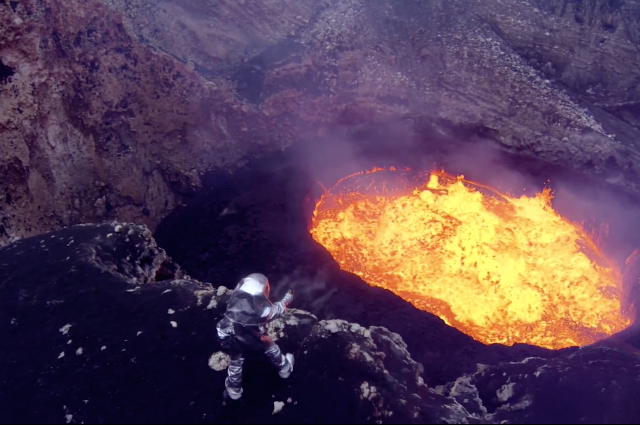It looks like you're using an Ad Blocker.
Please white-list or disable AboveTopSecret.com in your ad-blocking tool.
Thank you.
Some features of ATS will be disabled while you continue to use an ad-blocker.
18
share:
What drone's are good for...
From IFL Science
Video technology and science converge on an active volcano in Vanuatu, where explorer Sam Cossman operated camera-mounted drones to capture high-definition images of the spectacular yet dangerous Marum Crater. Cossman and his team piloted the drones over the 7.5-mile-wide (12-kilometer) caldera
Imagine walking THAT close to the mouth of a Volcano!!! The sacrificial drone's were put to good use! Super cool footage.
From IFL Science
Video technology and science converge on an active volcano in Vanuatu, where explorer Sam Cossman operated camera-mounted drones to capture high-definition images of the spectacular yet dangerous Marum Crater. Cossman and his team piloted the drones over the 7.5-mile-wide (12-kilometer) caldera
The active volcano in Vanuatu proved too much for the drones flying over the fiery, spitting pit of lava. Thankfully, the filmmakers were able to capture stunning videos and thousands of photographs before the drones were either consumed by the lava itself or damaged from the incredible amount of heat emanating from it.
"It’s a glimpse into the center of the Earth," said Sam Cossman, an explorer and filmmaker on the mission. "It’s like listening to the heartbeat of the planet.”
Marum crater is a 7.5-mile-wide caldera in Ambrym, a volcanic island in the archipelago of Vanuatu, with poisonous chlorine and sulfur gases that rise from its vent. The large volcanic crater made news last September when a daredevil donned a protective suit and rappelled as close as he could to the churning lake of lava.
Screen capture from National Geographic video
However, the purpose of this particular mission was to investigate how quickly microbial colonization happens on nearby rocks. “The instant the rock cools to below about 120 degrees Celsius, it’s considered an inhabitable environment,” said Jeffrey Marlow, a geobiologist from California Institute of Technology, who participated in the study. “Getting a handle on how microbes colonize this particular substrate is a good example of what will happen across the planet and has happened across the planet throughout geological time."
Apart from providing striking images, the cameras will help the scientists determine how far they were from the volcano when sampling the rock as well as provide 3D reconstruction of the crater.
Imagine walking THAT close to the mouth of a Volcano!!! The sacrificial drone's were put to good use! Super cool footage.
edit on
3/1/2015 by DjembeJedi because: (no reason given)
I have always seen those guys with they shinny suits and wonder, if they get splashed by the lava it will just poke a hole throught the guy? That
stuff is just to reflect some heat to not get cooked.
Lava looks so cool, and I bet the cameras were a higher sacrifice than the 80 bucks drone
Lava looks so cool, and I bet the cameras were a higher sacrifice than the 80 bucks drone
edit on 1-3-2015 by Indigent because: (no reason
given)
a reply to: DjembeJedi
I hope that before I die I can make a trip to see a volcano that close. It is simply amazing.
I see a energy source there that could supply a nation maybe more if one could figure out how.
I hope that before I die I can make a trip to see a volcano that close. It is simply amazing.
I see a energy source there that could supply a nation maybe more if one could figure out how.
Absolutely amazing video! Captivating! I would love the opportunity to experience a volcano up close. I have always found them to be fascinating. I
did get a chance a few years ago to see an inactive volcano near Ceboruco en Jala, Nayarit, Mexico but it was nothing like what is shown in the video.
Thank you for posting...
Ok, it was interesting, but I'll admit I kept waiting for the fiery drone death.
Where was the fiery drone death? For some reason I was convinced there would be fiery drone death.
Where was the fiery drone death? For some reason I was convinced there would be fiery drone death.
edit on 1-3-2015 by ketsuko because: (no
reason given)
Wow, that was some of the best volcano footage I've seen yet! Thanks
On a side note.. did that lava look CG to anyone else? I'm guessing it was because of the Go-Pro trying to compensate for the dark surroundings and super bright lava, but it was violent and awesome non-the-less.
On a side note.. did that lava look CG to anyone else? I'm guessing it was because of the Go-Pro trying to compensate for the dark surroundings and super bright lava, but it was violent and awesome non-the-less.
new topics
-
Covid....... Again.
Diseases and Pandemics: 22 minutes ago -
US Federal Funding set to Expire December 20th. Massive CR on the way.
Mainstream News: 50 minutes ago -
and14263 New Account Not the Same Old Me
Introductions: 2 hours ago -
Just spotted an unusual aircraft Melbourne Australia
Aliens and UFOs: 9 hours ago
top topics
-
Mass Shooting Towson, Maryland - 7 shot, 1 possibly dead
Social Issues and Civil Unrest: 17 hours ago, 7 flags -
The truth lets admit it
Aliens and UFOs: 14 hours ago, 6 flags -
Just spotted an unusual aircraft Melbourne Australia
Aliens and UFOs: 9 hours ago, 5 flags -
US Federal Funding set to Expire December 20th. Massive CR on the way.
Mainstream News: 50 minutes ago, 3 flags -
Covid....... Again.
Diseases and Pandemics: 22 minutes ago, 3 flags -
and14263 New Account Not the Same Old Me
Introductions: 2 hours ago, 0 flags
18

